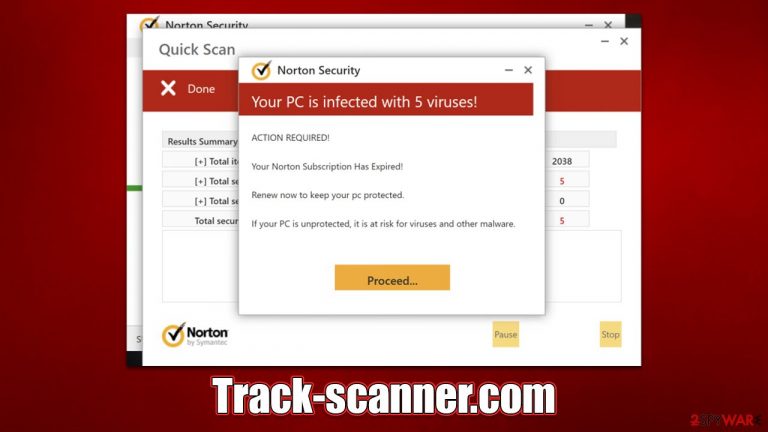Track-scanner.com ads (fake) - Free Guide
Track-scanner.com ads Removal Guide
What is Track-scanner.com ads?
Track-scanner.com is a fake site that imitates a virus scan to make people purchase software

Users who end up on Track-scanner.com are greeted with fake messages and scams designed to intimidate them. While adware[1] infection might be the reason for redirects to this site, more likely causes include malicious links or automatic redirect scripts on other websites. Once redirected, they never expect to see what's actually there – which makes the scheme all the more successful for those running it.
After entering, users are informed that their system has been scanned for viruses by Norton. According to the findings, several infections were discovered, and the subscription to the security program had expired. They are encouraged to click on a link that will take them to a page where they can purchase a full license of the security app.
In reality, there is no connection between Track-scanner.com and Norton. Scammers created this website solely to generate income through clicks on affiliate links. For regular users, it's also challenging to determine whether a redirect to a security software download site is authentic, so you might unknowingly install malware onto your computer instead of a legitimate program.
| Name | Track-scanner.com |
| Type | Scam, phishing, redirect, adware |
| Operation | Claims that viruses have been found on the system and that the security software has expired. Asks to purchase a license and enable push notifications |
| Distribution | Compromised websites, pop-up ads, potentially unwanted applications |
| Risks | Loss of finances due to fake subscriptions, redirects to other malware-laden, scam websites, installation of potentially unwanted or malicious software |
| Removal | Interacting with the scam content is dangerous, as scammers may promote fake versions of antivirus software. Instead, use reputable tools for malware removal |
| Other tips | Third parties can use cookies to continue tracking your online activities, so we recommended clearing browser caches and other leftover files with FortectIntego |
Signs to look out for when dealing with suspicious websites
The probability of encountering suspicious content online increases drastically whenever users intentionally visit websites of dubious origin. For example, those that choose to download illegal software are much more likely to be exposed to malware or links that lead to phishing,[2] gambling, or other dangerous sites.
While being careful online is extremely important, it is not always possible to avoid websites like Track-scanner.com, so if you do encounter them, you should know what to look out for. Your number one hint that the site is not what it pretends to be is the URL – Track-scanner.com is not an official website of a security vendor represented there.
Besides, any online “scanners” that detect viruses on your system are simply fake, as only reputable security software installed on your device can detect and remove malware. The same goes for the messages which claim that Flash Player or other software is outdated or missing, and they are all likely to result in malware infection instead.

How to clean your device from infections
Oftentimes, people come across Track-scanner.com ads as a result of being redirected from another website; however, this could be due to adware. Adware is software that focuses on advertisements and provides few benefits for users. Since the creators of these apps rely on unstable advertisement networks, individuals may experience phishing messages, websites that advertise PUPs, and other unwanted content, more frequently.
To discover whether your computer is infected with malware, you may use SpyHunter 5Combo Cleaner or Malwarebytes antivirus software to scan it. All threats will be instantly removed due in part to the program's automatic nature. If you want to do it manually instead, you can check for potentially unwanted programs yourself. Because most adware nowadays take a form of a browser extension, start by removing all the suspicious extensions as follows:
Google Chrome
- Open Google Chrome, click on the Menu (three vertical dots at the top-right corner) and select More tools > Extensions.
- In the newly opened window, you will see all the installed extensions. Uninstall all the suspicious plugins that might be related to the unwanted program by clicking Remove.

Mozilla Firefox
- Open Mozilla Firefox browser and click on the Menu (three horizontal lines at the top-right of the window).
- Select Add-ons.
- In here, select the unwanted plugin and click Remove.

MS Edge
- Open Edge and click select Settings > Extensions.
- Delete unwanted extensions by clicking Remove.

Safari
- Click Safari > Preferences…
- In the new window, pick Extensions.
- Select the unwanted extension and select Uninstall.

While it is rare, adware could still be installed on your device at the system level. Look for video converters, system optimizers, driver updaters, and other suspicious programs you don't remember installing (or you do, and the suspicious redirects started right after you implemented them).
Keep in mind that all potentially unwanted applications would be detected and removed by security software if they are installed this way, so you can skip this step if you aren't entirely sure – better leave it for anti-malware to deal with it.
Windows
- Enter Control Panel into the Windows search box and hit Enter or click on the search result.
- Under Programs, select Uninstall a program.

- From the list, find the entry of the suspicious program.
- Right-click on the application and select Uninstall.
- If User Account Control shows up, click Yes.
- Wait till uninstallation process is complete and click OK.

Mac
While moving apps into Trash is how you delete most normal applications, adware tends to create additional files for persistence. Thus, you should look for .plist and other files that could be related to the virus. If you are not sure, skip this step entirely.
- From the menu bar, select Go > Applications.
- In the Applications folder, look for all related entries.
- Click on the app and drag it to Trash (or right-click and pick Move to Trash)

To fully remove an unwanted app, you need to access Application Support, LaunchAgents, and LaunchDaemons folders and delete relevant files:
- Select Go > Go to Folder.
- Enter /Library/Application Support and click Go or press Enter.
- In the Application Support folder, look for any dubious entries and then delete them.
- Now enter /Library/LaunchAgents and /Library/LaunchDaemons folders the same way and terminate all the related .plist files.
After you take care of any browser extensions and programs, be sure to clear cookies and other data that could lead to more ads or unwanted tracking. FortectIntego is great for this as it can clean out all browsers and the entire system from leftover junk files, thereby improving performance. Plus, it can fix any virus damage caused by adware or malware.
Annoying pop-ups showing up all the time? You might have enabled Track-scanner.com push notifications
Websites that show users their computer is in danger and then attempt to sell them software are not only dishonest but also aggressive in monetizing. As soon as you enter one of these websites, they'll ask you to enable push notifications so that more misleading advertisements can be pushed through the built-in browser API.[3]
If you accidentally or intentionally clicked the “Allow” button within the prompt that is shown upon website entry, you would later start seeing intrusive pop-ups showing malicious content and links to suspicious websites. Ignore these and follow the steps below to get rid of this annoying activity.
Getting rid of Track-scanner.com ads. Follow these steps
Stop browser notifications
Remove unwanted notifications from Google Chrome (desktop):
- Open Google Chrome browser and go to Menu > Settings.
- Scroll down and click on Advanced.
- Locate Privacy and security section and pick Site Settings > Notifications.

- Look at the Allow section and look for a suspicious URL.
- Click the three vertical dots next to it and pick Block. This should remove unwanted notifications from Google Chrome.

Remove unwanted notifications from Google Chrome (Android):
- Open Google Chrome and tap on Settings (three vertical dots).
- Select Notifications.
- Scroll down to the Sites section.
- Locate the unwanted URL and toggle the button to the left (Off setting).

Remove unwanted notifications from Mozilla Firefox:
- Open Mozilla Firefox and go to Menu > Options.
- Click on Privacy & Security section.
- Under Permissions, you should be able to see Notifications. Click the Settings button next to it.

- In the Settings – Notification Permissions window, click on the drop-down menu by the URL in question.
- Select Block and then click on Save Changes. This should remove unwanted notifications from Mozilla Firefox.

Remove unwanted notifications from Safari:
- Click on Safari > Preferences…
- Go to the Websites tab and, under General, select Notifications.
- Select the web address in question, click the drop-down menu and select Deny.

Remove unwanted notifications from MS Edge:
- Open Microsoft Edge, and click the Settings and more button (three horizontal dots) at the top-right of the window.
- Select Settings and then go to Advanced.
- Under Website permissions, pick Manage permissions and select the URL in question.

- Toggle the switch to the left to turn notifications off on Microsoft Edge.

Remove unwanted notifications from MS Edge (Chromium):
- Open Microsoft Edge, and go to Settings.
- Select Site permissions.
- Go to Notifications on the right.
- Under Allow, you will find the unwanted entry.
- Click on More actions and select Block.

Remove unwanted notifications from Internet Explorer:
- Open Internet Explorer, and click on the Gear icon at the top-right of the window.
- Select Internet options and go to the Privacy tab.
- In the Pop-up Blocker section, click on Settings.
- Locate web address in question under Allowed sites and pick Remove.

How to prevent from getting adware
Choose a proper web browser and improve your safety with a VPN tool
Online spying has got momentum in recent years and people are getting more and more interested in how to protect their privacy online. One of the basic means to add a layer of security – choose the most private and secure web browser. Although web browsers can't grant full privacy protection and security, some of them are much better at sandboxing, HTTPS upgrading, active content blocking, tracking blocking, phishing protection, and similar privacy-oriented features. However, if you want true anonymity, we suggest you employ a powerful Private Internet Access VPN – it can encrypt all the traffic that comes and goes out of your computer, preventing tracking completely.
Lost your files? Use data recovery software
While some files located on any computer are replaceable or useless, others can be extremely valuable. Family photos, work documents, school projects – these are types of files that we don't want to lose. Unfortunately, there are many ways how unexpected data loss can occur: power cuts, Blue Screen of Death errors, hardware failures, crypto-malware attack, or even accidental deletion.
To ensure that all the files remain intact, you should prepare regular data backups. You can choose cloud-based or physical copies you could restore from later in case of a disaster. If your backups were lost as well or you never bothered to prepare any, Data Recovery Pro can be your only hope to retrieve your invaluable files.
- ^ Adware. Investopedia. Source of financial content on the web.
- ^ Phishing attacks. Imperva. Application and data security.
- ^ Application Programming Interface (API). IBM. Cloud Learn Hub.
